
OPERATING TRAINS
IN THE ROCKIES
By H.C. Taylor
Superintendent of Transportation Western Lines
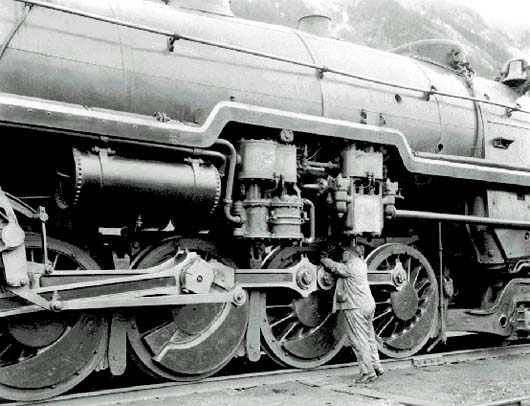
2-10-4 Selkirk class T1a number 5910 at Field - Date/photographer unknown.
 Introduction Many years ago Canadian Pacific published a series of ten books named the "Foundation
Library". One particular book in this collection, published in 1937, is named "Factors in Railway and Steamship Operation". It
contains many short stories and articles dealing with the company during that period. This month's article is from that book, "Operating
Trains in the Rockies", written by H.C. Taylor, Superintendent of Transportation Western Lines, and reprinted here for your enjoyment with
the addition of some appropriate images.
 The 1937 Article Three generations of Canadians have grown up with Canadian Pacific railway-development. The audacity
of the pioneers who conceived the idea of piercing the mountains with steel is a Canadian tradition and a boast of Empire. Day after day and night
after night great trains, drawn by huge locomotives, haul tons of dead weight up mountain grades with a maximum of efficiency and a minimum of
operating cost. It is possible that the story of Canada's scenic grandeur, told in pictures and travel books, overshadows this tale of daily
achievement of the railway's operating force. The wonder is that tons of freight and express, as well as thousands of passengers, daily make the
grades which carry them over a line of steel from coast to coast.
Granted that mile after mile of steel extend into distance on the level, nevertheless in the West this line of steel at some points in British
Columbia actually lies a mile above sea level. As far as possible, the Canadian Pacific Railway main line through the mountains follows the water
courses, taking the lowest grades.
Crossing the mountain barrier from the prairies to the Pacific Ocean, the Canadian Pacific breaks through four separate ranges. These are the
Rocky Mountains, extending from the Alberta foothills to Golden, B.C., a distance of approximately 125 miles; the Selkirks, which extend from
Beavermouth, farthest north on the Canadian Pacific, to Revelstoke; the Gold Range of the Monashee Mountains, west of Revelstoke, and the Coast
Mountains, 100 miles or more inland from the Pacific Ocean.
Although the Selkirks and the Rockies approximate each other in altitude, the highest point on the railway line is at the Great Divide, at
Stephen, 5,337 feet above sea level and on the boundary between Alberta and British Columbia.

A grade profile chart of Canadian Pacific's mainline between Vancouver and Calgary.
Clearly to appreciate the mechanics of train operation through the mountains it may simplify matters to follow the course of these two lines of
steel stretching westward.
From Calgary west, the Canadian Pacific parallels the Bow River to Lake Louise, follows a tributary to Stephen, and descending the west slope of
the Rockies follows the Kicking Horse River through the canyon to Golden where it empties into the mighty Columbia River.
The railway follows along the Columbia to Beavermouth where the Beaver River, running east, joins the
Columbia, which there turns north to make its wide sweep into the Big Bend country before returning south through Revelstoke to and through the
United States and on to the Pacific Ocean at Portland. From Beavermouth the line takes the Beaver River up the east slope of the Selkirk Range
and from the summit at Glacier parallels the Illecillewaet down the west slope to Revelstoke, where the Illecillewaet joins the Columbia.
West of Revelstoke, the railway crosses the Gold Range of the Monashee Mountains at Eagle Pass, picks up the Eagle River while descending the
west slope, and follows it to Sicamous, at which point the Eagle River flows into Lake Shuswap. From this point the line follows the lake which
eventually becomes the south arm of the Thompson River; then on to Kamloops, joining the north Thompson, through to Lytton, where the Thompson
joins the famed Fraser, rushing on through Fraser Canyon to the Pacific.
The original line, built more than 50 years ago, was considered suitable for conditions existing at that time. Later, with the increase of
traffic and the need for improved service and economical operation, certain sections of the line were diverted and the grades reduced. Notable
projects accomplished with this end in view were the building of the two spiral tunnels east of Field and the five-mile, or Connaught tunnel,
under Mount Macdonald between Connaught and Glacier.
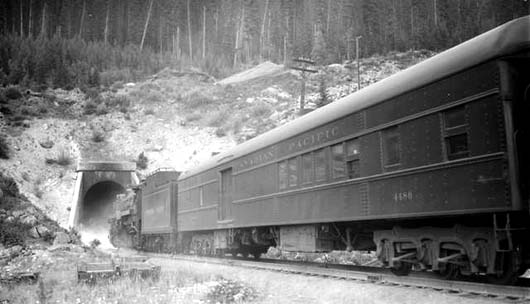
The Dominion entering the Lower Spiral Tunnel - 1938 Otto Perry.
In the early days of Canadian Pacific railroading, the line east from Field, on the west slope of the Rockies, ascended almost a quarter of a
mile in the 11 miles of track to the summit at Stephen. This was a most difficult grade, a maximum of 4.5 percent, which meant a lift of 4 1/2
feet in every 100 feet of track, and costly in operation.
Canadian Pacific engineers overcame these handicaps by building the two spiral tunnels, one 3,255 feet long and the other 2,922. These were
completed in 1909 and have since become significant landmarks known by travellers from all parts of the world. Each makes a complete circle under
the mountain, and in so doing the maximum grade between Field and Stephen was reduced to 2.2 percent. The old grade is now used as part of the
highway east from Field.
The Connaught tunnel, just as significant but 5.02 miles long, was completed in 1916. This engineering feat shortened the main line by 4.3
miles.
The old line crossed the summit of the Selkirks through Rogers Pass, 552 feet higher than the new,
continued along Bear Creek, turned to Glacier, and then back to the Illecillewaet River in a series of sharp curves. It was one of the most
spectacular of mountain rail routes, but involved expense in operation and persistent necessity for the maintenance of long snow sheds as
protection against slides.
The summit of the new line through the Selkirks is a few hundred feet inside the west portal of the tunnel, the track ascending for this
distance, then on an easy grade to the east portal. Huge power-driven fans housed at the west portal keep the tunnel free from gases.
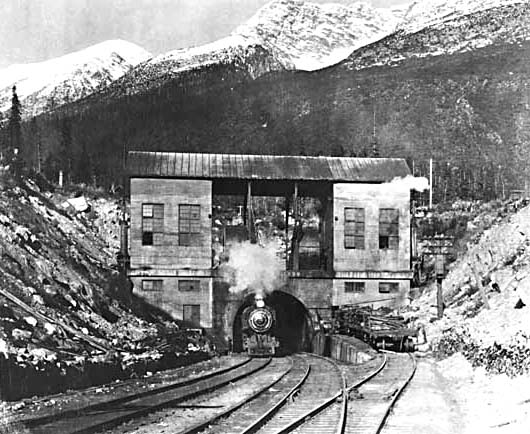
Ventilation building at the west portal of the Connaught Tunnel at Glacier, British Columbia - Date unknown Leonard Frank
- Vancouver Public Library 12295A.
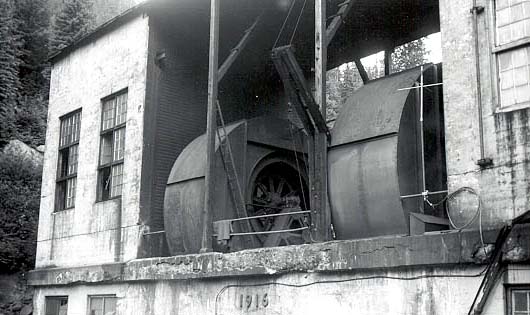
A closer look at the ventilation fans for the Connaught Tunnel at Glacier, British Columbia - 1971 William Slim.
Following the line on the east slope of the Rockies, it makes a gradual descent to Lake Louise, 116 miles west of Calgary. The maximum grade is
slightly more than 1 percent but rises sharply from Lake Louise in the 8 miles to the summit at Stephen, although on this stretch the grade is
only 1.8 percent. The reason for this is the long, gradual ascent of the east slope, in contrast to the steep western slope down the Kicking
Horse Valley, which requires a series of 2.2 percent. grades to reach the river level at Field, 14 miles from the summit at Stephen.
From this description it is clear that each section of mountain lines requires different methods of train operation, depending upon length and
nature of grades.
The primary responsibility of handling trains with their heavy and precious freight over this difficult western territory rests with the
Superintendent of Transportation, Western Lines. Some idea of the task involved is presented in his observations on the general methods followed.
In the operation of trains over the mountain ranges safety regulations must be rigidly adhered to.
From the Superintendent's office in Winnipeg are sent out general instructions controlling the shuttle-like accuracy of Western train movements.
Specialized knowledge on the part of men engaged in every branch of railway service has produced a highly efficient body of men in charge. They
know their mountains and are qualified to cope with all problems of mountain operation.
Between Field and Revelstoke are experienced the most difficult operating conditions. This is the Mountain Subdivision, famed to the tourist for
its magnificent scenery and to the railway man for its operating problems.
Twenty mammoth "T1" locomotives, especially designed for heavy mountain service, and a lesser number of "S2" pushers haul
freight and passenger trains over this 125 mile stretch of track. The big "T1's" are of the 2-10-4 type, with five pairs of drivers
and a tractive effort of 89,000 pounds. Each is equipped with "boosters" which add power for the easier starting of heavy trains and
the acceleration of speed following the start.
Notwithstanding their power, one of these monster locomotives can haul only 1,050 tons of dead weight up
the mountain grades. This is the equivalent of about 12 carloads of grain. Compare this with the 70 or 80 car trains hauled with ease by smaller
engines over the prairie.
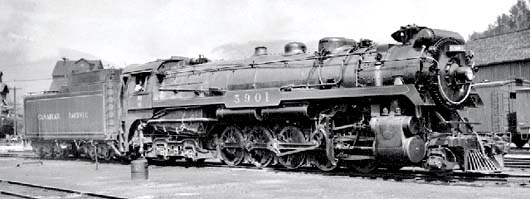
2-10-4 Selkirk class T1a number 5901 - Date/photographer unknown.
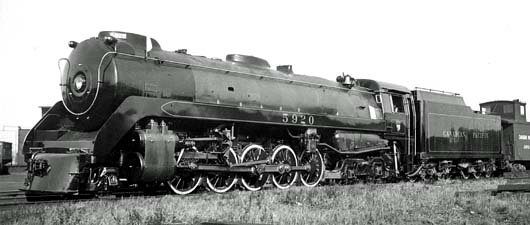
2-10-4 Selkirk class T1b number 5920 - Date/photographer unknown.
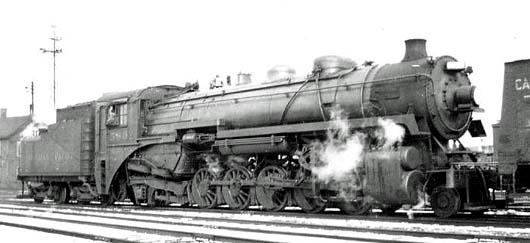
2-10-2 Santa Fe class S2a number 5802 - Date/photographer unknown.
In the approach to the Mountain Subdivision is the section between Calgary and Field known as the
Laggan Subdivision. In this region transcontinental passenger trains are handled by oil-burning engines of the "G4" class or
"2700" 4-6-2 type, with two pairs of pony trucks, three pairs of driving wheels, and a trailing engine truck, and with a tractive
effort of 44,000 pounds. One of these engines will haul a heavy passenger train between Calgary and Lake Louise, but needs a second engine, or
"helper", from Lake Louise to the summit at Stephen.
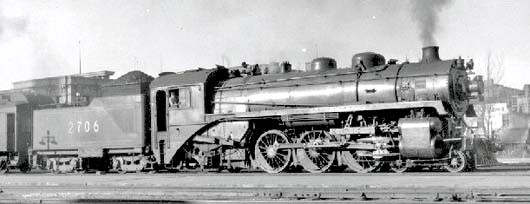
4-6-2 Pacific class G4 number 2706 at Calgary, Alberta - Date/photographer unknown BC Archives.
The same assistance is needed ascending the west slope from Field to Stephen. A second helper is required to haul the train up the "big
hill", eastbound, because of the heavier grade and a sometimes greasy track encountered in the spiral tunnels due to condensation from fuel
gases which settle on the rails.
Eleven "P2" engines of the 2-8-2 type 58,000 pounds tractive effort, with six "S2" class "helpers", especially
designed for the purpose, are in use for freight trains on this section. A single engine handles a 2,250 ton freight train between Calgary and
Lake Louise.
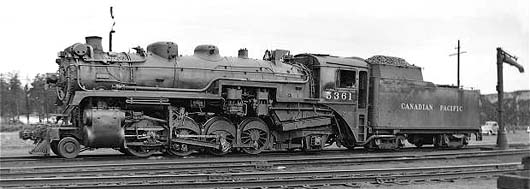
2-8-2 Mikado class P2e number 5361 - Date/photographer unknown.
Infinite care accompanies the operation of trains over these and other mountain ranges, and the rigid regulations imposed by the authorities
become a matter of conscience with the good railwayman.
Beginning a descent, previously examined air-brakes are applied. Trainmen examine the brake on each car to ensure perfect functioning. Air brakes
are then released and re-examined to see that all brake shoes are clear of the wheels. They are again set at the required pressure and retaining
valves set up on cars to maintain pressure on each, and the train slowly proceeds down hill. On long grades stops must be made at stated points
to allow the wheels to cool, should any be found overheated through constant pressure of the brake shoes.
Aside from heavy grades, probably no factor contributes as much to cost of operation as train delays. The Canadian Pacific consistently justifies
its boast that its trains keep to schedule.
Some may consider that to obtain maximum efficiency and minimum operating costs freight trains should be
loaded to the capacity of the locomotive at all times, a few cars set off here and there when somewhat heavier grades are encountered, or a few
cars picked up after grades have been passed. Experience, however, proves this principle can be applied to advantage to a limited extent only,
unless there be a wide spread between engine tonnage capacities over the various grades. For this reason freight trains which may be taken
through intact are usually operated over the various subdivisions, with the required number of pusher engines provided to assist them over the
grades. These pusher engines and their crews are stationed at Golden and Beavermouth and are called upon when needed.
The preponderance of "loaded" cars, in the case of freight trains, is westward over the mountains, and this traffic direction controls
the size and number of freight trains operated. If the volume of traffic is heavy, the greatest economy in operation is effected by hauling
maximum tonnage. One of these huge mountain engines can handle almost any number of cars down the hills. The governing factor is the weight one
engine can haul up the east slope of the Selkirks from Beavermouth to Glacier, or up the west slope from Revelstoke to the summit.
It is inevitable, therefore, that trains are made up at Field for the trip to Revelstoke in units of 1,050 tons, the capacity of one locomotive,
2,100 tons, 3,150, or 4,200 tons, depending on the number of cars to be moved. On arrival at Beavermouth, one, two, or three pushers, as may be
required, are cut into the train to take it up the hill.
In this connection, a somewhat unusual practice is followed, and differs from the popular idea of the pusher as a double header, two engines on
the head end. Four engine trains are run when sufficient tonnage offers, the engine which takes the train over the entire run being on the head
end, one pusher placed just ahead of the caboose, and two together at the centre of the train. This is done on the principle that the leading
engine pulls to the extent of its capacity; the first of the two in the centre pushes its tonnage; the second in the centre pulls its share;
while the one immediately ahead of the caboose pushes its weight.
If only two pushers are needed, one is placed ahead of the caboose and the other two-thirds of the way back in the train. If there is only enough
tonnage for a two-engine train, the pusher is placed next to the caboose.
In the case of eastbound trains the practice differs because, while the same tonnage restrictions prevail over mountain grades, trains in most
instances consist of a larger percentage of empty cars returning after having carried grain and other commodities to the Pacific Coast. This
allows for longer trains with less dead weight. It is seldom necessary, from a train tonnage standpoint, to use more than one pusher engine
eastbound.
The Transportation Superintendent summarizes by explaining that passenger trains westbound on this section of the mountain line are assisted by
one helper engine from Beavermouth to Glacier, and freight trains over the same line by one, two, or three helpers, according to the
weight of the train.
Eastbound freight and passenger trains are assisted from either Revelstoke or Albert Canyon to Glacier
and from Golden to Field when required.
Less difficult of operation is the Shuswap Subdivision. Between Revelstoke and Kamloops only one pusher is needed to assist freight and heavy
passenger trains west from Revelstoke and east from Taft over the Gold Range of the Monashee. The same operation is followed over Notch Hill,
which is what its name implies, only a hill, not a mountain.
Pushers are called out from Revelstoke as required to help trains in either direction between there and Taft. Others, with their crews, are
stationed at Notch Hill to assist trains up the hill from Tappen, 10 miles east, or from Chase, 14 miles west.
Over this section of the line "R3" class engines are used in freight service, the 2-10-0 type with 58,000 tons tractive effort. With
assistance over Notch Hill and the Gold Range, they handle 3,343 tons eastbound and 2,864 tons west. They are coal burners.
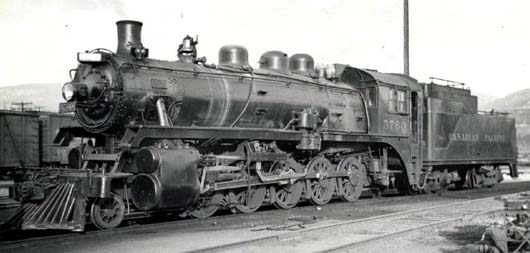
2-10-0 Decapod class R3 number 5760 - Date/photographer unknown.
Passenger trains over this part of the line, as well as between Kamloops and the Pacific Coast, are hauled by oil-burning "C4's", such
as are used on passenger trains between Field and Calgary. Incidentally, each of these locomotives handles a passenger train over the entire run
between Vancouver and Revelstoke.
The next barrier of importance lies between Spences Bridge and Ruby Creek, almost 100 miles, over the Coast Mountains.
Until a few years ago, grade conditions necessitated all freight trains westbound "doubling", or taking the train up in two pieces from
Savona to Walhachin, some 7 miles, and cutting each train in two for movement from the latter point to Ruby Creek. A grade revision project was
carried out and a locomotive leaving Kamloops westbound, with 2,865 tons, can now take the entire train to Spences Bridge, 40 miles west of the
former dead line.
From this point to Ruby Creek a series of grades necessitates that freight trains be cut in two, the "N2" class engine which hauls
2,865 tons from Kamloops to Spences Bridge having hauling capacity for only 1,450 tons from the latter point to Ruby Creek. The grades and
locomotive capacities in the other direction are substantially the same and "N2" engines can move 3,600 tons from Vancouver to Ruby
Creek, but take only 1,475 tons from the latter point to Spences Bridge.
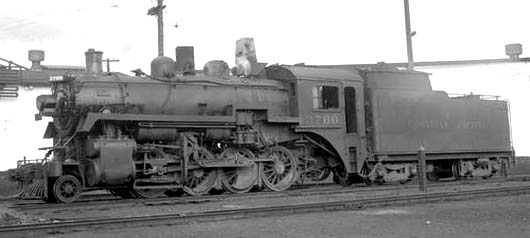
2-8-0 Consolidation class N2 number 3760 - Date/photographer unknown.
To fill this 100 mile gap and move the cars set out by through trains before passing over it, ten "P2" engines, such as are used on
freight trains between Calgary and Field, are stationed at North Bend to be called up as required to move this "set out" tonnage over
the high grade line through the Thompson and Fraser Canyons, between Spences Bridge and Ruby Creek. The original train then picks up what was
left behind or its equivalent.
The directing of train movements, over mountain lines involving tremendous wealth of commodity and
rolling stock, is directly controlled from Calgary, Revelstoke, and North Bend. Calgary takes care of the line to Field, including the "big
hill" and the spiral tunnels. Revelstoke controls the section from Field to Kamloops, and from the dispatcher's office at North Bend and the
superintendent's headquarters at Vancouver are controlled the operations from Kamloops to the Pacific Coast.
Supervisory staffs are located at the headquarters mentioned. At these points train dispatchers observe a never-ceasing vigilance. They arrange
meeting places between trains and supervise train movements which are regulated by certain specific rules complicated to the layman, but simple
and without possibility of misunderstanding to the train and engine men. By the use of train orders, issued by the dispatcher, the train crews
know exactly where to meet certain trains; that they must wait until a specified hour before leaving designated stations; and any other
instructions necessary to the safe handling of the precious cargoes.
To the layman, if he gives it any thought at all, the safe transit of freight commodities, including everything from feathers to farm implements,
must be a constant wonder. Literally thousands of tons are moved from week to week and find their destination with uncanny speed and accuracy.
Train dispatching alone involves a department whose work runs with unceasing regularity and technical skill. The train dispatching circuit is of
copper wire to guard against interruptions which may be experienced on a line more susceptible to weather interference. It has direct
communication with operators at strategic points, each or any of whom can be summoned by a calling system in the dispatcher's office. This is a
simple device, utilizing a different electric impulse for each office by the mere turning of a button on the panel in front of the dispatcher's
desk which in unwinding taps off 3-4-2, or whatever the particular office combination may be, and rings a bell in the operator's office. The
dispatcher, of course, must be constantly on the telephone circuit; the operator only when summoned.
Train crews are provided with portable telephones which, in emergency, may be attached to the
dispatcher's circuit at any point by hooking the caboose telephone line over the telegraph wires wherever the train may be.
A series of "hill" telephones is located at various points in the mountain regions by which track watchmen can acquaint the train
dispatcher with conditions which may arise from time to time.
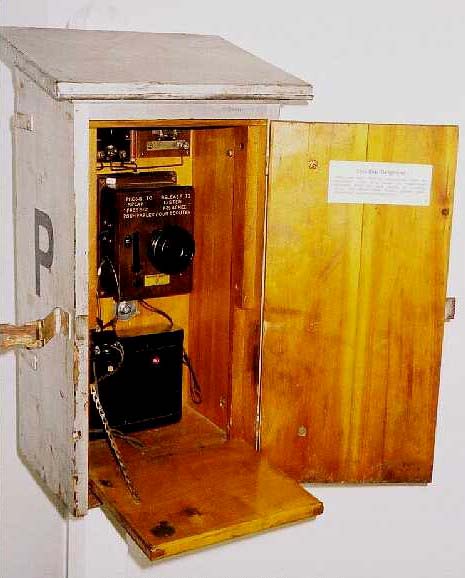
Lineside phone box - Date/photographer unknown.
This is a brief recital of operating methods over the Canadian Pacific main line through the mountains. It is not intended to convey the
impression that operating conditions here are more severe than on other railways facing similar obstructions on the North American or other
continents.
Back-stage, unseen by patrons, is an array of skilled employees, track watchmen, men experienced in the maintenance of automatic block signals,
section foremen, and staffs quick to detect faults in track or roadbed, train and engine men who are experienced in mountain operation, and
officers who keep watchful eye and are able to sense changing conditions, because mountain railway operations present problems not encountered
elsewhere.
Anyone who has travelled across Canada from coast to coast must be impressed with the ever-changing view. Orchards give way to forests; stretches
of farm lands are interspersed with areas of rock and scrub; miles of country hide tremendous potentialities of forest and mineral wealth; vast
plains lie rich in food for the nations' granaries; stately and magnificent mountains provide beauty for the world's great show-place, the
so-called Canadian Rockies, really a succession of mountain ranges sloping to range lands on the east and on the west to rich fruit valleys,
forest reserves, and a world shipping outlet. And shuttling back and forth with clock like precision, Canadian Pacific trains provide the medium
of trade.
 Associated Web Sites Canadian Pacific Railway
Royal Canadian Pacific
Canadian Pacific Historical Association
Additional CPR Web Sites

|

